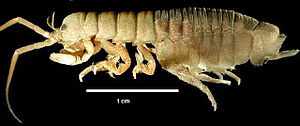Satchel crabs
| Satchel crabs | ||||||||||||
|---|---|---|---|---|---|---|---|---|---|---|---|---|

Australian water louse |
||||||||||||
| Systematics | ||||||||||||
|
||||||||||||
| Scientific name | ||||||||||||
| Peracarida | ||||||||||||
| Calman , 1904 |
Peracarida or Peracarida are a superiority of the higher cancers (Malacostraca) and belong to the crustaceans (Crustacea). These include woodlice , amphipods and hover shrimp .
Occurrence
Satchel crabs occur in all types of water and also on land. They have a worldwide distribution and often a large density of individuals. Their own brood care mechanism contributes to their success in the various habitats, including in the deep sea , the Arctic and the Antarctic as well as in special biotopes such as caves, groundwater or in the sand gap system .
Reproduction
Brood care: The eggs are kept in a ventral brood chamber, called marsupium , on the thorax (the only exception is the group of Thermosbaenacea). This space is separated from the external medium by flap-like, adjoining appendages of the extremities (oostegite).
Nervous system and sensory organs
In most cases the eyes are set sessile in the head plate.
morphology
Satchel crabs have a carapace with a maximum of four fused thorax segments. The head is fused with one (or two) segments of the thorax. The carapace fold has mostly receded.
Tribal history
Early fossils of the satchel crab orders such as Isopoda , Cumacea and Tanaidacea are known from the Paleozoic more than 300 million years ago. The ancestors of the Amphipoda also come from this geological age, even if no fossils of this group of animals have survived from this period. The satchel shrimp continued to spread in the Mesozoic . The current distribution of the Crangonyctidae , a very original group of Amphipoda in the northern hemisphere, points to their origin in Laurasia even before the Jura .
Systematics
The hierarchy of the satchel crabs (Peracarida) comprises nine orders:
- Suspended shrimp (Mysida) Haworth, 1825
- Lophogastrida Sars, 1870
- Flea Shrimp (Amphipoda) Latreille, 1816
- Cumacea Kroyer, 1846
- Mictacea Bowman, Garner, Hessler, Iliffe & Sanders, 1985
- Spelaeogriphacea Calman, 1904
- Thermosbaenacea Monod, 1927
- Scissor Woods (Tanaidacea) Dana, 1849
- Woodlice (Isopoda) Latreille, 1817
Westheide and Rieger distinguish only seven orders in their special zoology . They contrast the satchel shrimp (Peracarida) with the Thermosbaenacea as a pancarida, because, in contrast to the other Peracarida, they use their carapaceous cavity on their back as a breeding space. The brood chamber of the remaining peracarida lies on the stomach side. Furthermore, the Mysida and the Lophogastrida are combined to form the order of the Mysidacea.
Individual evidence
- ↑ Wilfried Westheide and Reinhard Rieger (eds.): Special Zoology. Part 1: Protozoa and invertebrates. 2nd edition, Elsevier, Spektrum Verlag, 2006
literature
- Wilfried Westheide and Reinhard Rieger (eds.): Special zoology. Part 1: Protozoa and invertebrates. 2nd edition, Elsevier, Spektrum Verlag, 2006, ISBN 3-8274-1575-6 .
Web links
- The European orders of the satchel crabs (Peracarida). In: Fauna Europaea Database. European Commission under the Fifth Framework Program, accessed on March 11, 2014 .

